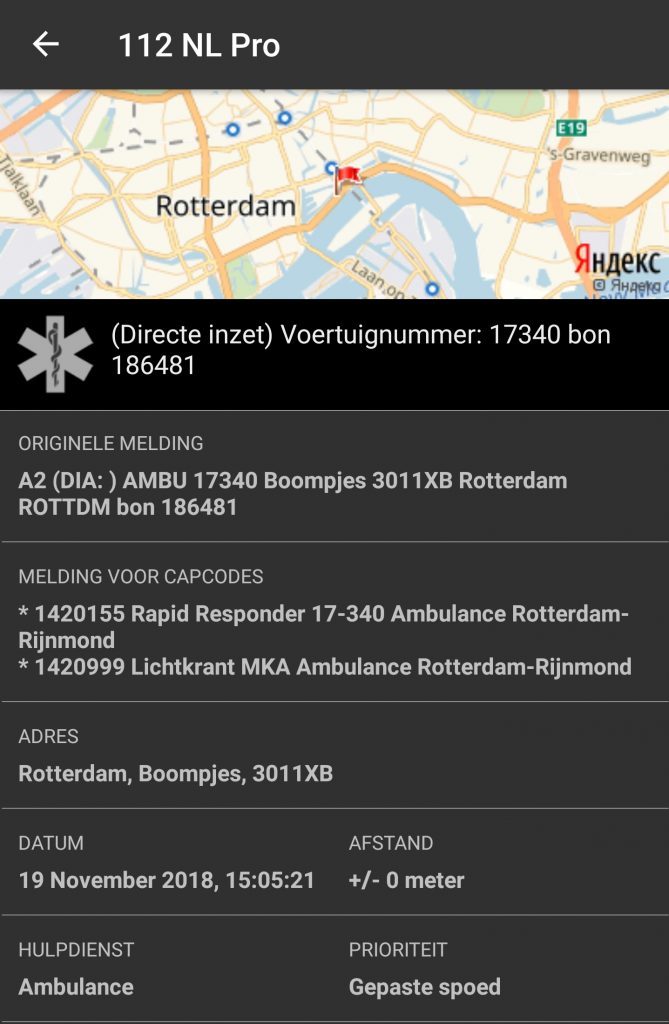Within Netherlands each company is by law required to have first responders. These handle various situations until the professionals arrive. It’s usually one of (possible) fire, medical or an evacuation. Normally I’d post this at Google+ but as that’s going away I’ll put it on this blog. I prefer writing it down so later on I still can see the details.
While standing a bit away from my desk it seems security (via the walkie talkie) asks for either me or Tim. I didn’t hear my name properly, but I’m pretty sure I heard them call out for Tim. After asking to repeat I get sent to 10th floor and informed that another person is also underway. There’s an ambulance underway and that’s basically all the information available.

I take a bright jacket, AED and run to 10th floor. I arrive at the same time as another first responder. Strangely nobody seems stressed. No group of people anywhere, etc. Though the floors are huge it usually only takes seconds to figure out the location of an incident. We ask around and nobody seems to be aware of any incident. We advice security and get sent to investigate on 9th floor. Apparently the floor number was unknown and this company is located on two floors with the majority on 10th floor. On 9th floor we notice the issue quickly and advise security. Just after we overhear (walkie talkie) the arrival of a rapid responder. The incident is quite easy, the person is lying on the floor with a coolpack, conscious, did not lose consciousness and just tripped because of a slippery floor.
Such an incident could be more serious, it’s quite possible that some kind of problem in their brain caused them to lose consciousness and that resulted in a broken ankle. During the last first aid refresher course they taught us to be aware that the real cause might be a bit different.
As the rapid responder is already within the building I decide not to treat the ankle. The ankle was already being cooled and it seems better to leave it to the professionals. Someone asks for a update to relay to the rapid responder, I respond and keep it brief.
Meanwhile more first responders arrive as well as interested colleagues. As per a tip from another first responder I give all kinds of tasks to the newly arrived first responders. One I ask (tell) to get all other colleagues away. Another is sent to get the persons jacket. Yet another is sent to the elevators to guide the rapid responder towards the incident.
Once the professional arrive we stand at a distance. We discussed if we should ask the rapid responder if he requested an ambulance but it was decided to better not to ask questions unless you really need to. This especially as the rapid respond is on his own. We prepare for a possible ambulance to arrive. This as a rapid responder (either motorcycle or a smaller car) cannot move people. It’s a bit overkill to use an ambulance for a broken ankle, but oh well. I volunteer to wait for the ambulance in the cold. Apparently there’s a reserved elevator which I can use (one which only responds to buttons within the elevator). Outside I see that the rapid responder parked in an interesting location and it might make things difficult. I check for any ambulance calls on my app, plus change the app to show me non-priority calls as well. If an ambulance comes I’ll need to ask for a lot of assistance. We had enough which responded.
After standing outside for a while I hear that the plan changed. The reserved elevator needs to go back to 9th and they’ll use a chair to move the person. On 9th floor I had to wait a while so to kill the time I ask how to reserve an elevator. I only know how to takeover the emergency elevator. Taking over a random one? I thought only security could do this. Tim explains it to me after which a bunch of people arrive, including someone in a chair. We guide the person downstairs. Person is then brought to the hospital by a colleague. We aren’t sure why the rapid responder didn’t bring the person. After the incident security ensures I can also reserve elevators.
During the whole incident we only used walkie talkies. Another way is pagers, worn by more people than the usual first responders. The pagers have as drawback that you might get an overkill of first responders. We recently changed procedures to optimize this a bit. It’s still nice to see how many responded just based upon walkie talkie usage.